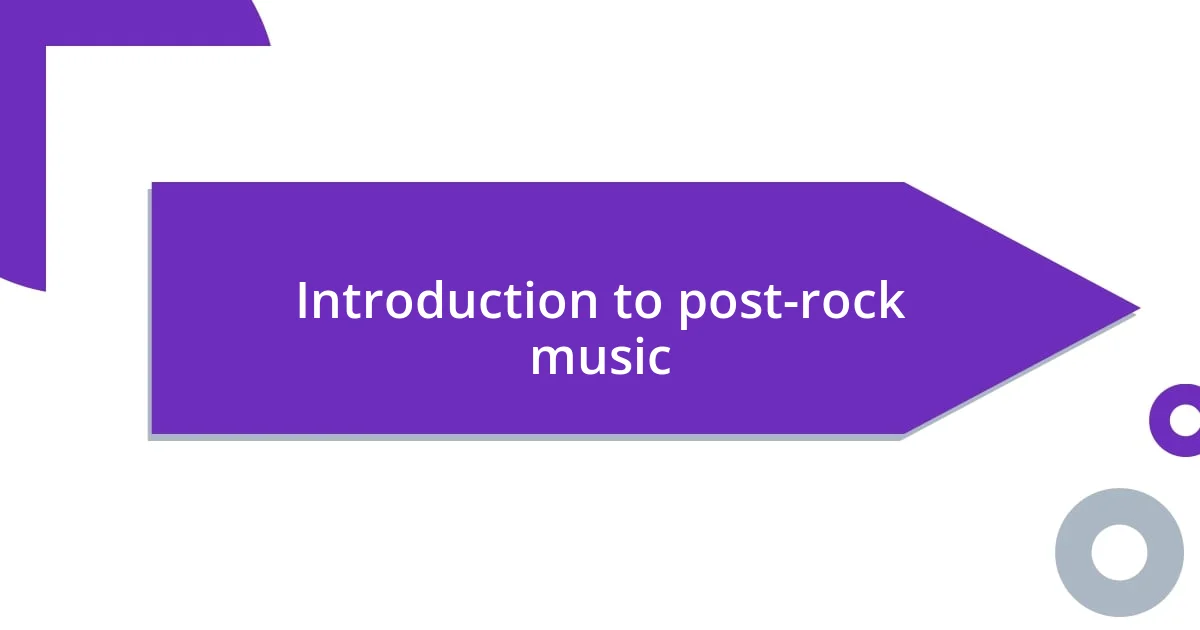Key takeaways:
- Post-rock music, emerging in the late 1980s, emphasizes atmosphere and texture over traditional song structures, often inspiring deep emotional reflections.
- Key characteristics include dynamic shifts, immersive soundscapes, and the intentional use of silence, enhancing the listener’s personal connection to the music.
- Notable post-rock artists like Explosions in the Sky, Sigur Rós, and Godspeed You! Black Emperor exemplify the genre’s emotional depth and narrative quality through their influential albums.

Introduction to post-rock music
Post-rock music, for me, has always felt like an exploration of sound beyond traditional structures. I remember the first time I listened to Explosions in the Sky; it was as if I’d been transported to an entirely different emotional landscape. The slow build-ups, the crescendos, and the delicate interplay of instrumentation moved me in ways I hadn’t expected.
This genre, emerging in the late 1980s and gaining traction throughout the ’90s, defies typical songwriting conventions. It often prioritizes atmosphere and texture over melody. I sometimes wonder, what is it about the absence of lyrics that allows for such deep, personal reflection? For many, myself included, the music acts as a canvas where emotions can be painted without the confines of words.
Listening to post-rock can evoke images and memories, almost like a soundtrack to one’s life experiences. I recall lying on the grass, letting tracks like “Your Hand in Mine” wash over me, feeling both a profound sense of loss and a shimmering hope. Isn’t it fascinating how instrumental music can articulate our feelings more eloquently than words ever could?

Key characteristics of post-rock
Post-rock is characterized by its expansive arrangements and dynamic shifts, often taking the listener on a journey rather than adhering to conventional song structures. I’ll never forget a moment during a long drive when I played Godspeed You! Black Emperor’s “Storm,” which perfectly illustrated this characteristic. The gradual build-up, rich layers of sound, and eventual release felt like a story unfolding, immersing me in a beautifully chaotic emotional experience.
Another significant aspect of post-rock is its emphasis on texture and ambiance, creating soundscapes that evoke particular feelings or landscapes. I remember attending a local show where a lesser-known band played a set that felt like wandering through a misty forest. Their use of reverb-drenched guitars and gentle strings transported the audience into a realm of ethereal beauty. It’s truly magical how a simple chord progression can evoke such vivid images and emotions, right?
Moreover, the use of silence as an instrument in post-rock is intriguing. I once listened to a track that carefully balanced loud and soft sections, where the pauses created tension that enhanced the overall experience. This often results in moments of reflection and anticipation that keep listeners engaged, allowing them to truly connect with the music on a personal level. Isn’t it captivating how such contrasts can mirror life’s pendulum between chaos and stillness?
| Characteristic | Description |
|---|---|
| Dynamic Shifts | Post-rock’s use of gradual build-ups and crescendos creates emotional journeys. |
| Texture and Ambiance | Focus on creating immersive soundscapes that evoke feelings and imagery. |
| Use of Silence | Incorporating pauses enhances tension and allows for personal connection. |

Exploring the genre’s history
Post-rock music’s journey began in the late 1980s when bands like Slint and Talk Talk started to push the boundaries of rock, experimenting with atmospheric soundscapes and unconventional song structures. I find it remarkable that this genre, often seen as a niche, has woven its way into the fabric of modern music, influencing countless artists across various genres. Personally, I remember discovering early post-rock tracks and feeling as though I had stumbled upon a secret world where sound and emotion were intertwined.
- Origins in Experimental Rock: The genre roots trace back to influential bands like Slint and Talk Talk, who shifted focus from traditional song formats.
- Embracing Instrumentation Over Lyrics: Post-rock artists often prioritize instrumentation, creating emotional narratives without words.
- Rise in the ’90s: The genre gained significant recognition during the ’90s, with bands such as Godspeed You! Black Emperor and Explosions in the Sky taking it to new heights.
- Soundtrack Influence: It’s fascinating how post-rock has become a preferred choice for film soundtracks, enhancing visual narratives with its evocative soundscapes.
Each time I delve into the rich history of this genre, I can’t help but think of those early days when discovering something like Sigur Rós felt like unearthing buried treasure. Their ethereal sound evoked feelings I couldn’t quite place, almost like a long-forgotten memory. This exploration of history highlights how these early influences laid the groundwork for a movement that continues to resonate with listeners seeking depth and introspection.

Influential post-rock artists to know
When discussing influential post-rock artists, it’s impossible to overlook the impact of Explosions in the Sky. I distinctly remember discovering their album “The Earth Is Not a Cold Dead Place” during a rainy afternoon. The lush guitar melodies and heart-wrenching crescendos made me feel an overwhelming sense of hope amidst despair. How is it that music can capture such intricate emotions? It’s moments like these that remind me of the profound connection between sound and feeling.
Another shining star in the post-rock constellation is Sigur Rós, whose sweeping soundscapes transport me to otherworldly realms. Their unique use of the Hopelandic language adds a fascinating layer to my listening experience. I vividly recall the first time I played “Sæglópur”; it was as if a fog had lifted, revealing a breathtaking landscape in my mind’s eye. Isn’t it amazing how simply shifting language and sound can evoke vivid imagery? That’s the beauty of their music.
Lastly, we can’t forget about Godspeed You! Black Emperor, whose cinematic compositions often feel like a sonic exploration of human emotion. I first encountered their “Lift Your Skinny Fists Like Antennas to Heaven” while reading late at night. The track’s dynamic shifts from haunting ambient moods to chaotic crescendos left me breathless. It made me ponder, what stories do these sounds tell? This band exemplifies how post-rock artists use their craft to weave complex narratives that resonate deeply with listeners.

Essential post-rock albums to listen
When it comes to essential post-rock albums, one that stands out to me is “Those Who Tell the Truth Shall Die, Those Who Tell the Truth Shall Live Forever” by Godspeed You! Black Emperor. Listening to this record for the first time felt like embarking on an epic journey without ever leaving my room. The way the band masterfully blends field recordings with orchestral arrangements invites a sense of reflection that lingers long after the final note fades. Have you ever had an experience where music transcends mere listening and becomes a profound experience? That’s exactly what happened to me.
Another album that deserves a spot on any post-rock playlist is “The Earth Is Not a Cold Dead Place” by Explosions in the Sky. I recall lying on the floor, headphones on, as the opening track “First Breath” washed over me. The shimmering guitars and build-ups created an emotional wave that swept me away, making me feel simultaneously small and infinite. It’s fascinating how a simple melody can evoke such a range of emotions, isn’t it? This album captures the essence of what post-rock is all about: a deep connection between the music and our innermost feelings.
Lastly, Sigur Rós’s “Ágætis byrjun” is a must-listen for any post-rock enthusiast. I vividly remember pressing play on this album and being immediately transported to a dreamlike state. The ethereal quality of Jonsi’s voice and the rich instrumentation felt almost otherworldly, as if each song was an invitation to explore a fantastical landscape. Have you ever found a piece of music that felt like it transcended language altogether? That’s the power of Sigur Rós and their ability to evoke profound emotions purely through sound. Each listen brings new layers of meaning, reminding me how endlessly fascinating post-rock can be.

Techniques used in post-rock music
When I delve into post-rock music, one technique that truly stands out is the use of dynamic shifts. For instance, the way a song can start with delicate, whisper-like notes and gradually swell into a wall of sound is breathtaking. I remember listening to a track that began with soft piano chords, and as the layers built up, I felt like I was being swept away on a tidal wave of emotion. Isn’t it captivating how these gradual transitions can transform a simple melody into an exhilarating journey?
Another fascinating aspect is the incorporation of unconventional instruments and effects. I once stumbled across a post-rock band that featured a church organ in their arrangements. The deep, resonant tones added a haunting quality to their music that left me chilled and enchanted. It’s moments like this that remind me how broad the palette is for sound in this genre. Why limit ourselves to traditional instruments when you can evoke something so profound with unexpected choices?
Finally, let’s not overlook the art of slow build-ups. There’s something uniquely satisfying about a song that takes its time, carefully layering each element before reaching a climactic peak. I recall a particular piece that navigated through ambient soundscapes for nearly ten minutes before exploding into a cacophony of guitar and drums. It was as if I had been patiently waiting for the perfect moment, and when it arrived, it felt like all my pent-up emotions released at once. Have you ever felt that exhilarating anticipation in a song? That’s the magic of post-rock: it teaches us the beauty of patience within music.














